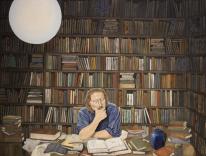Any moment now Josephine Jacobsen's seventh volume of poems will be out: New and Selected Poems and The Sisters, (South Carolina: The Bench Press, 1987). Her first book, Let Each Man Remember, appeared in 1940, so this makes her forty-seventh year as a public poet. She has just returned from a gathering of the Poetry Consultants to the Library of Congress, a position she held from 1971 to 1973. She has done her stint of work for the Literature Panel of the National Endowment for the Arts, and co-authored two volumes of criticism. She is a distinguished reviewer of poetry, identifying the ways of the poet with an intelligent and savory discrimination. She has been in an old-fashioned sense, a woman of letters, a friend, colleague, and encourager of poets.
She has had a long association with Commonweal, sending us poems, reviews, and an occasional article. Her first poem for us was published in 1958 and for it she received $7.50; her most recent poem for us earned $10. If you have stock in poetry, it's good to know that the price of poems remains steady. My rough addition of the checks sent to her noted in our quaint files says we have paid her over twenty-six years a total of $707.50, if that fact is significant to the archeologist of poetry.
At a time decades ago when "religious" poetry was plentiful, she was recognizable as a Catholic poet, and now in leaner times, there is the same proportion of religious imagery in her poems. She is steady. We get in The Sisters what we got in The Animal Inside (Ohio University, 1967) twenty years ago, very crafty poems, richly-minded.
I want to talk about her images and thematic ideas to introduce new readers to her poems and encourage old readers to give themselves the pleasure of rereading. To make it easy for any reader to plunge in, I offer the sort of list Randall Jarrell used in his poetry essays, a selection of ten poems to show something of her range in her most typically perfect poems. This is a back-against-the-wall choice and may outrage readers who could make up their own list.
Volumes by Jacobsen
The Animal Inside, Ohio University Press, 1967, 113 pp. Abbreviated here: AI.
The Shade-Seller, Doubleday, 1974, 133 pp. Abbreviated here: SS.
The Chinese Insomniac, University of Pennsylvania Press, 1981, 79 pp. Abbreviated here CI.
The Sisters, the Bench Press, 1978. Abbreviated here TS.
Josephine Jacobsen, like her contemporaries Auden, Roethke, Elizabeth Bishop, writes "modernist" poems, in which every part builds up a metaphoric or mythic whole. Language and myth in these poems implicate: their parts imply each other. As you read it, the poem seems to unfold. The ending articulates the beginning, so endings are subtle and satisfying. A surprise seems to "solve" the poems, but the end was there in the beginning, in, say, the metaphor or word-play latent in the radical of a word.
Here are some examples. The insomniac speaker of one of Mrs. Jacobsen's poems anticipates the release dawn will bring her. When the cock crows, "the dark is crazed like a plate" (SS 47). Crazed describes the breaking of dark like pottery glaze, implies the plenty of light you need to see such a fine pattern. Psychologically, crazed displaces and lightly disarms the insomniac's state of mind. The speaker of "Short Views in Africa" (CI 54) spends the night watching the wild animals through "the blind's/ chink," a nice predicament. A chink is a good vantage and a good focus, but blind rather cancels the advantage. The swimmers in The Sisters are trying to stay safe against an "invisible tide." But the poet points out that these tides have "come from over the bones of boys,/ of girls gone down...." So when from these waters the swimmers emerge "brilliant with drops," the word drops has emerged from "gone down," and the swimmers "rise" in an imagined or humanized "resurrection," though that's the reader's word, not the poet's.
Myth-wise, the modern poem is a kind of palimpsest, to use Galway Kinnell's word: an inscription written on a parchment over a barely visible mythic text not quite scraped off. For example, "A Motel in Troy, New York," (CI 64) begins with a shadow falling on cribbage players from their motel window.
A huge swan
is looking in: cumulus-cloud body,
thunder-cloud dirty neck
that hoists the painted face
coral and black. Inky eyes
peer at our lives.
The swan is very accurately observed. But the more perceptively humans see animals, the more unnervingly alien they appear. The words inky and painted seem plainly descriptive, but they are terms from human culture. They signify writing or print and art, so they set the animal swan a little more apart from us. What is set apart always begins to feel like the sacred. The swan is ordinary, of course, with its "dirty neck."
It stands
squat on its yellow webs
splayed to hold
scarcely up the heavy
feathered dazzle.
The ironic finesse of the writing (from squat to feathered dazzle) is a wonder and a pleasure, and such poems don't have to mean more than their triumphant writing. But the poem isn't over.
The swan breaks its stare and "waddles rocking" to the pond where it "Sets sail" and in its element is transformed "in one pure motion." It grows distant, and as the poem ends, the swan becomes less self-contained than its natural description implied. The swan is
received by distance
and the shadowy girl
across the water.
What girl? says the ordinary reader who is familiar with—has been through—Troy, New York. Then the faint text under the newer ink of this present poem appears. The momentary puzzle of the ending sends us back to reconsider the "cumulus-cloud...thunder-cloud," sky-god aspect of the swan. "Set sail" now seems suggestive, if Troy makes us think of Agamemnon's expedition.
An early twentieth-century poet would have made the swan incandesce into its myth. Yeats's poem names Leda and Agamemnon, though not Zeus, and enacts a vision of a pagan annunciation. But Mrs. Jacobsen's poem isn't simply understating Yeats or Greek myth. What interests her is the way the humans see the swan, and the way the swan turns away from our lives so that we can't receive it, as animal or god. The "shadowy girl" is the Leda or vanishing point of our perception. The poem is a human look at something not human, ending in the irony of the absent girl—for without Leda, the swan can't be Zeus. In Yeats's poem the annunciation depends on the god; in Mrs. Jacobsen's poem the existence of the myth depends on the imagined, human girl.
The poem pulls out a whole tissue of Josephine Jacobsen's thematic images. Two especially are remarkable: the Animals and the Watcher or Watchman. Animals to begin with are partly the "animal inside," anima, the sensate flesh and bone, the principle of bodily life or body-soul. Mrs. Jacobsen is clearly an incarnationalist. Partly the animal is the wild in its constant but alien relation to the human: "The wild is a way of breathing; a kind of breath" (SS 25). So the animal or the wild is the mind's longing for metaphor or antithetical images of itself. Hummingbirds, working metaphors like all animals to the imagination, teach the Trinity:
requiring three in one — light,
angle, eye, to flower
into their color....
Interference is the cause of irides-
cence...
its color is structural....(SS 104).
The poem "Bush" (TS 79) describes lions leaving a water hole at dawn. There is no mention of their kill, but a few lines later we see that
the drum of the zebra's body
is lined with red sunrise.
The metaphor skips the "natural'' link of the lions and their prey, the zebra, and connects the opened body of the zebra to the rising sun.
A Choice of Poems
"Painter at Xyochtl," from AI, reprinted in SS.
"Yellow," from AI, reprinted in TS.
"The Murmurers," from AI, reprinted in SS.
"An Absence of Slaves," from SS, reprinted in TS.
"The Mexican Peacock," from TS.
"Mr. Mahoney," from CI.
"A Motel in Troy, New York," from CI.
"Food," from CI.
"Distance," from TS.
Metaphor is the structural equivalent of consciousness and self-consciousness, the Both/Otherness of human perception. The best example is the cave painter of the hunt in the poem "In the Crevice of Time" (SS 33 and TS 91). Looking at his painting he sees:
not shank or horn or hide
but an arrangement of these by
him, and he himself
there with them, watched by him-
self inside.
Apart, the painter arranged. At the same time he has painted himself, and so he is present, identifying-with, "there with them." And all of it is "watched by himself inside."
In the dialectic of consciousness, absence evokes presence; deserts more than strawberry gardens hum "like wire with absent water" (SS 97). The natural insomniac can't sleep through the dark, but moral or metaphoric insomnia is the power to stay awake and take in the dark. The refusal to accept "distance" is a mode of conscience. The starved child, nothing but "skin, breathing/ wrapped over bones,"—when that child is "overseas"—is not on our own doorstep. When we can ignore it because it is distant, then we "feel distance...as a priceless pain-killer/ locate and disconnect, reality." So "Distance is our quack-doctor.''
The latest version of this doubleness turns up in the title poem of The Sisters. One sister, "B," like a daylight self, is "better adjusted." The other, "A," is both sharp-eyed," and "a great sleeper." She is apt to return to "some spot they've already seen" and talk about it when she gets back. As letters, A and B, they suggest writing and language, or one woman divided into her self-sisterness: "Before bed, A looked at herself in the mirror, using B's eyes."
"Identify what you will not renounce" (TS 10) might be one of Josephine Jacobsen's mottos. In her body of poetry crowded with losses, almost no poem without its image of death, she works harder at identifying than lamenting. The watcher is awake because her brain is working. Writing lets us look at ourselves in its mirror, using the writer's eyes. We are grateful we've had Josephine Jacobsen's steady eyes for so long.
Please email comments to [email protected] and join the conversation on our Facebook page.
Previous Story
An Interview with Elie Wiesel
Next Story
The Long Trip Home


